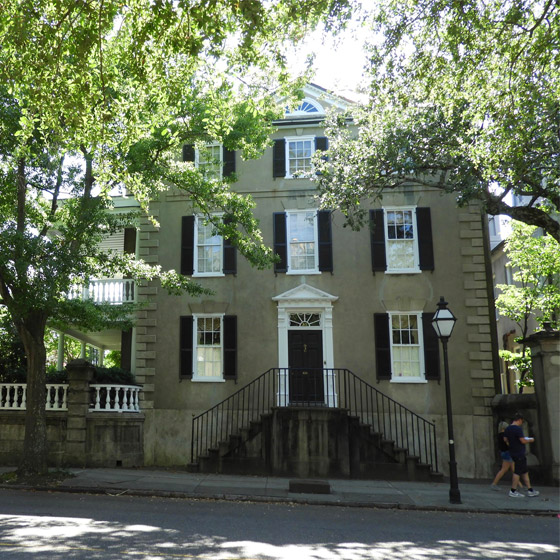
35 Meeting Street
The lot at 35 Meeting Street was acquired by Stephen Bull in 1694, and his son William built the stuccoed brick house (minus the piazzas, which were added much later) around 1720. Three and one-half stories on top of a raised basement make this single-family residence one of the most imposing houses of the colonial era in Charleston. 35 Meeting Street is also a house infused with the early history of Charles Town.
The Bull family, originally from England, was much involved in the early proprietary and royal governments. Stephen Bull of Kingshurst Hall, Warwickshire, England came to Carolina in 1670 on the first ship to settle here, the "Carolina." He came as the personal representative of Lord Anthony Ashley Cooper, one of the eight Lords Proprietors to whom King Charles II gave the land known as Carolina in gratitude for the restoration of the English monarchy.
Stephen was instrumental in selecting the site for Charles Town on the peninsula and, among other positions, he served as Surveyor General of Charles Town. He was given a land grant on the Ashley River, where he built his home "Ashley Hall." It was here that his son William, the builder of 35 Meeting Street, was born in 1683. His grandson William II was also born there in 1710.
Like his father, William was also a surveyor. He helped General Oglethorpe mark out the plan of both the Georgia colony and the city of Savannah, which is sometimes referred to as Charleston's sister city. William was on the Proprietary Governor's Council during the period that Charles Town was leaving proprietary rule to come under royal rule, but was obviously respected enough to be appointed to the Royal Council. Later, he was appointed Lieutenant Governor of the royal colony at a time when the colony was without a governor. William governed South Carolina for the next five years until the governor finally arrived in Charles Town.
William's daughters married into the early prestigious planter aristocracy of South Carolina. One daughter married Thomas Drayton of Magnolia Plantation, another married John Drayton of Drayton Hall, and another married Henry Middleton, President of the Second Continental Congress.
William's son, William II, lived at 35 Meeting and was the first American to receive a medical degree following his study in England. In the family tradition, William II also served the province in various governmental positions. Like his father, William II was Lieutenant Governor of the royal colony for many years. In fact, he was the Lieutenant Governor when Lord Campbell, the last royal governor of the colony who was living right across the street at 34 Meeting, escaped in the middle of the night with his wife to England. William II remained a loyalist to the English Crown, leaving Charles Town in 1782 at the end of the Revolutionary War. He died in England in 1791.
Join me next week as we pursue more Charleston history through her structures.



